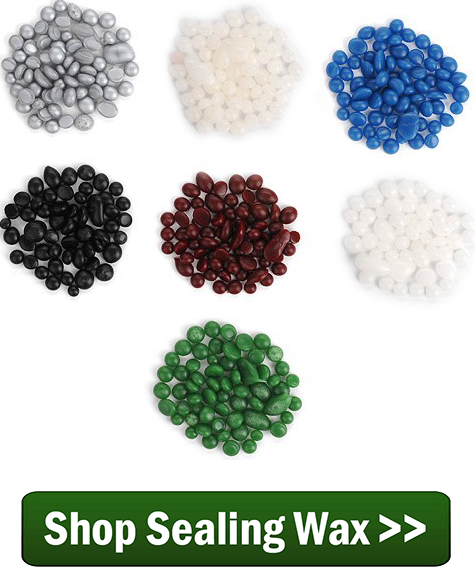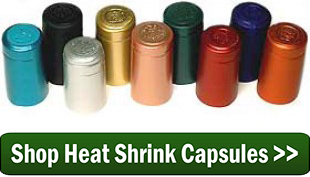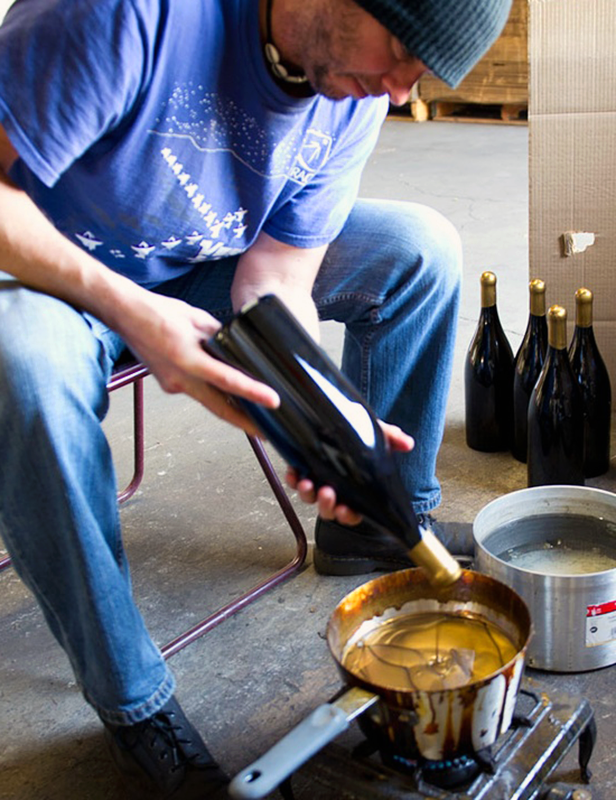Did not receive any instructions on how to use the bottle sealing wax beads I ordered . What is the best method to melt the wax beads. Have never used this wax before. Do you sell some type of melter. If you would please let me know how to use.
Thanks,
Sammy L.
—–
Hello Sammy,
How you use the bottle sealing wax can vary somewhat. There is not a specific way it has to be used.
We recommend melting the sealing wax in a tin of the appropriate size. This can be something as small as a soup can if you are only doing 5 bottles. If you are doing 50 bottles you may want to use something as large as an old 2 pound coffee can tin. Sit the tin in a pan of water to make a double boiler on the stove. This will help the wax to heat more evenly over a period of time.
Once the sealing wax is melted you will want it to stay in that tin, permanently. The wax if very hard to remove once in a container, so don’t actually put the bottle sealing wax in any good pots or pans, themselves.
How to use the bottle sealing wax is something that can be approached from a couple of different angles:
- Dip the whole neck of the wine bottle into the sealing wax.
Not only will the wax be sealing the wine bottle air-tight, but it will also become part of the wine bottle’s decorative decor. The colors look incredible against the glass and can work together with the wine label to a bottle of wine worth sharing.The downside is that this method can use up quite a bit of bottle sealing wax. One pound of wax will do about 40 to 80 bottles depending on how far you dip the neck into the wax. You may also need more sealing wax than this to create a reservoir deep enough to coat the amount of the bottle neck you want. This is dependent on the profile of the tin you select.
- Pour the sealing wax directly onto the cork itself.
The second way to use the sealing wax is more efficient but not as decorative. Inset the cork by an eighth to a quarter of an inch into the neck of the wine bottle. Then pour a disk of wax into the inset. You will want to pinch a spout onto the tin you are using. Heat protective gloves will be needed for this method, as well. Just like dipping the bottle into the wax, the cork is sealed air-tight, but will use much less sealing wax per wine bottle. You will usually get about 150 bottles per pound done with this method.
As you can see, how to use bottle sealing wax beads is open to some interpretation. If you are looking for full decorative value, dip the bottle neck into the sealing wax. If you are only wanting to make a better seal then use the second method and add a layer of sealing wax on top of the cork, itself.
Happy Wine Making,
Ed Kraus
—–
Ed Kraus is a 3rd generation home brewer/winemaker and has been an owner of E. C. Kraus since 1999. He has been helping individuals make better wine and beer for over 25 years.


A nice aid to doing Ed’s second waxing technique is wrapping the top pf the bottle with 3-4 inches of blue painting tape, That way if your technique needs practice or your hand isn’t steady, you won’t pour wax all over the side of the bottle or on your bench. Allow the wax to harden well, then peel off the tape. I use sealing wax seals (you can get them @ Michael’s craft shops) with diff. letters to designate diff. wines. Saves me from labeling every single bottle, esp. those for home consumption. After pouring the wax, allow some time for it cool and solidify, then press the stamp into the wax.
I am a bit confused, should I use wax for wine or only spirits? As I understand it, wines need to breath to age correctly which is what the cork allows. I just started wines last year so by no means an expert, just curious. Thanks!
Timothy, your assumption that the wax seals off the flow of oxygen to the wine is correct, and this needs to be taken into account before using it on your wine, but in some cases it matters less than others. Were slow oxygen seepage matters most is with heavily-bodied red wines. Wines will age to some degree whether or not air is allowed to seep past a cork. In some cases, the wine is aged sufficiently in bulk. Lighter, crisp wines tend to have a short life-span, so you will at times see these wine’s with a screw cap.
I am about to bottle some cherry wine I made. I was looking at the wax for sealing the bottles. Since it is a full-bodied red wine should I not use the wax method? I also have made a concord grape wine. Would I also not use the wax seal for that as well?
Angela, you can use the wax on any wine you like. However, when using the sealing wax it creates a very tight seal and can slow down the aging process.
Hello,
I’m wondering if you have any advice for wax-dipping a screw top bottle?
Kathy, there is no difference than dipping corked bottles.
I have a single electric hot plate purchased at a discount retailer and a few stainless steel small deep bowls I picked up a second-hand store. I work on a counter in the basement and use an old metal spoon to pour a plug into the top because I set the corks in deeper than the bottle rim. Once that wax hardens, I begin dipping the bottles. I always dip twice. It has al ways worked nicely, providing a neat, and a little rustic, finish.
Back in 2008, I made a very nice batch of Loganberry wine and set aside several bottles to use on special occasions. To make a long story short, when I recently opened a bottle it had oxidized. There was no sign of leakage, but the cork was stained about half of its length. My question: could this disaster have been prevented by using sealing wax ?
Sealing wax may have help, but it can not eliminate all affects of oxidation. True, it will stop new oxygen from getting into the wine, but there is also the affects of the oxidation with the oxygen that is already in the wine. This can be enhanced with excessive light and excessive heat.
An ideal vessel for melting wax is a small crock pot. It doesn’t get too hot and stays at a constant temperature. The one downside is that it takes some time to melt the wax, but once melted it keeps it at the correct temperature which is somewhere between 200-375 degrees F. I find that after I turn the bottle to evenly distribute the wax, a quick dip in room temperature water and swirling it while dipping provides a nice even finish and sheen. Be certain that the bottles and corks are quite dry before dipping and never mix hot wax and water. They are enemies! The unused can be stored in the crock pot until ready for the next batch.
So does anyone know if you can reheat the wax after it’s cooled and hardened in the slow cooker?
We’re doing 50 cases of port, so need to take breaks in between.